Metal Pushbutton with Wires - Latching (16mm, Green)
This is a perfect choice if you are in need of a heavy duty push button! These metal push buttons are a very tough, small, panel-mount latching switch with an illuminated green LED ring. It is a SPDT with 16mm threading and 1mm pitch. This button is perfect for basic On/Off functions. Overall length (including leads) is 1.5" and has small solder lugs for connection. These latched buttons are rated up to 3A and 250VAC while the LED is rated for 5-12V.
This pushbutton comes with a latching cable with 5 leads. Making it easier to attached to breadboards and extend the reach of your project.
Note: The images for this button show an LED voltage rating of 5V. We have verified that the voltage range for the the LED to be 5-12V. We are currently communicating with our supplier for new documentation. Trust the branding on the button to verify your voltage requirement.
- Stainless Steel Body
- IP65 Weatherproof Rating
- Tamper Resistant
- Latching Operation Type
- Green LED Ring
Metal Pushbutton with Wires - Latching (16mm, Green) Product Help and Resources
Wireless Audio Bluetooth Adapter w/ BC127
December 14, 2017
Build a custom wireless audio Bluetooth adapter using BlueCreation's BC127 and add it to your old speaker system!
Pinout
The pushbuttons (like the momentary https://www.sparkfun.com/products/11966 or latching https://www.sparkfun.com/products/11971 ) have an indication of the pinout of the buttons on the side of the plastic molding. One way to test the switch is to use a multimeter turned to the continuity setting. Here are what the pins (not in any particular order associated with the pushbutton's spades):
+ = LED Anode
- = LED Cathode
C = "Common Ground"
NC = Normally Closed
NO = Normally Open
One way to light the LED on the metal push button would require you to wire it so that when you press down on the button, the led would light up. You would need 5V to light the LED ring. It can be lit up with a smaller voltage but the LED won't light up as bright.
To connect the battery to the button so that it only lights when the switch is pressed down (momentary or latched), you would connect 5V to the "+" pin on the switch. This is assuming that your system is using the same voltage source that is 5V. Then from the "+" pin, you would wire it to the normally open (NO) pin.
Another wire would be connected from the "-" pin to the C pin. The C pin would essentially be connected to your ground. So as you press down on the button, it would flip the switch and complete the circuit from the normally closed (NC) pin to normally open (NO) pin while lighting the LED ring at the same time. It might be a good idea to use a current limiting resistor (like standard 330Ohm resistor) if you are using 5V directly from your power supply. The LED won't be as bright but you also wouldn't be reducing the life of the LED. I am not sure of the electrical characteristics of the LED that is in the pushbutton.
Core Skill: DIY
Whether it's for assembling a kit, hacking an enclosure, or creating your own parts; the DIY skill is all about knowing how to use tools and the techniques associated with them.
Skill Level: Noob - Basic assembly is required. You may need to provide your own basic tools like a screwdriver, hammer or scissors. Power tools or custom parts are not required. Instructions will be included and easy to follow. Sewing may be required, but only with included patterns.
See all skill levels
Core Skill: Electrical Prototyping
If it requires power, you need to know how much, what all the pins do, and how to hook it up. You may need to reference datasheets, schematics, and know the ins and outs of electronics.
Skill Level: Competent - You will be required to reference a datasheet or schematic to know how to use a component. Your knowledge of a datasheet will only require basic features like power requirements, pinouts, or communications type. Also, you may need a power supply that?s greater than 12V or more than 1A worth of current.
See all skill levels
Comments
Looking for answers to technical questions?
We welcome your comments and suggestions below. However, if you are looking for solutions to technical questions please see our Technical Assistance page.
Customer Reviews
3.3 out of 5
Based on 3 ratings:
2 of 2 found this helpful:
Great Pushbutton!
I ordered 16 of these for a project, and all 16 came in perfect working order. Using 12V for the LED, and the illumination level is great. All of the latching buttons work as expected; we'll see how they hold up over time. Contacts are well marked and easy to solder on leads. I found some off-the-shelf, pre-drilled wall plates at the hardware store that fit this button exactly and worked well for my application. Worth noting: This is a bit small for a button, and requires a deliberate action to push in, especially for people with larger hands. Not a problem, just the nature of the size of the object. Overall, I'm quite pleased with them. Will update this review if I start to have any QC issues.
0 of 2 found this helpful:
Extremely disappointed
It was long then I expected with the leads and they blew really easily

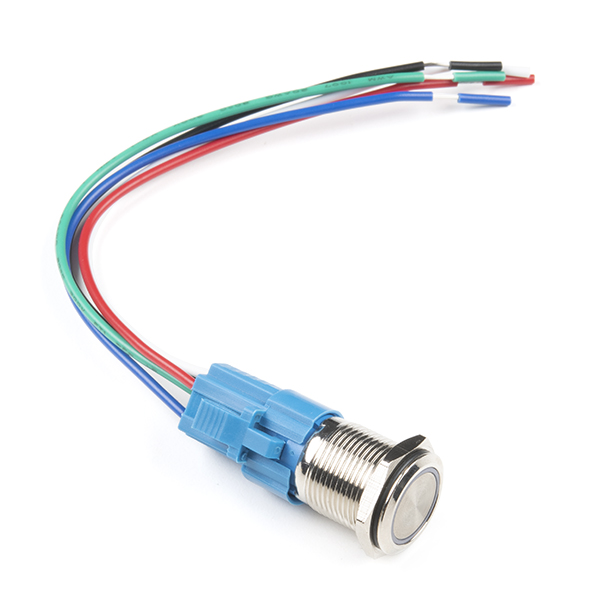
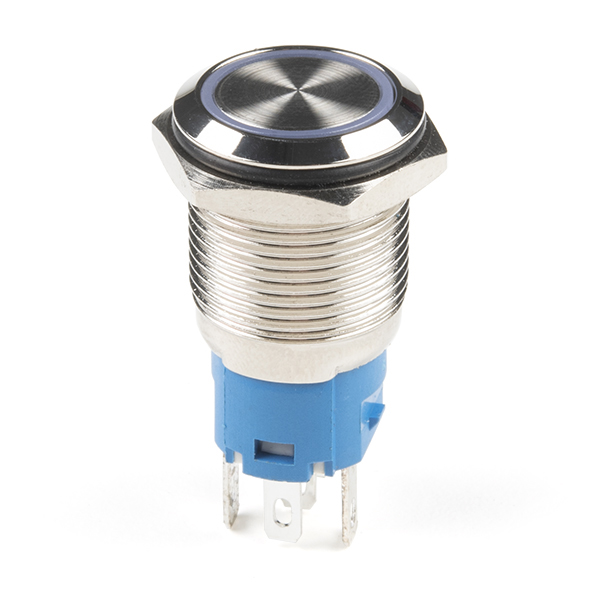
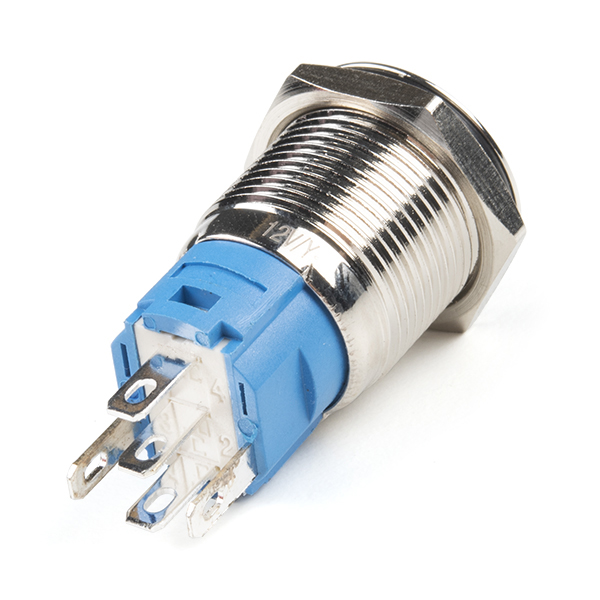
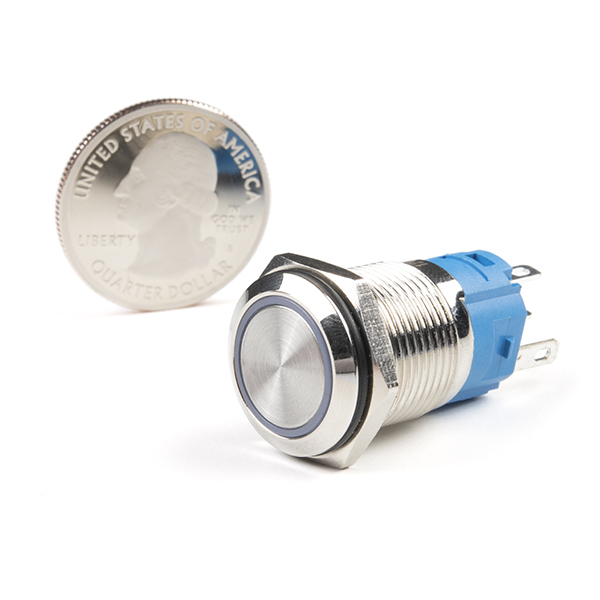
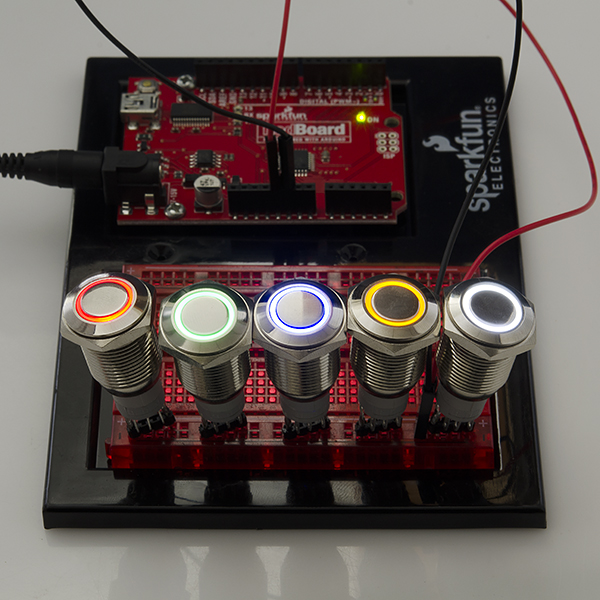
My god, these are gorgeous!
Can I use this directly as my on/off button for my system running off a 12v battery without frying the 5V LED?
You should be able to use the switch 'as is' - the LED is actually on the two outer pins, separate from the switch pins. You can't hook up 12V to the LED pins, you'll want to drop that down to 5V or ~18mA (a sibling product comment noted "On a bench supply, these red ones draw about 17mA at 5V").
Very much appreciated, thank you!